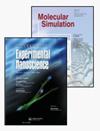Size effects on dislocation starvation in Cu nanopillars: a molecular dynamic simulations study
IF 2
4区 化学
Q4 CHEMISTRY, PHYSICAL
引用次数: 0
Abstract
ABSTRACTSize plays an important role on the deformation mechanism of nanopillars. With decreasing size, many FCC nanopillars exhibit dislocation starvation which is responsible for their high strength. However, many details about the dislocation starvation like how often it occurs, and how much is its contribution to the total plastic strain, are still elusive. Similarly, the size below which the dislocation starvation occurs is not clearly established. In this context, atomistic simulations have been performed on the compression of <110> Cu nanopillars with size (d) ranging from 5 to 21.5 nm. Molecular dynamics (MD) simulation results indicate that the nanopillars deform by the slip of extended dislocations and exhibit dislocation starvation mainly at small sizes (<20 nm). The frequency of the occurrence of dislocation starvation is highest in small-sized nanowires and it decreases with increasing size. Above the size of 20 nm, no dislocation starvation has been observed. Furthermore, we define the dislocation starvation strain and based on this, it has been shown that the contribution of the dislocation starvation to the total plastic strain decreases from 70% in small-sized nanopillars to below 5% in large-sized pillars. The present results suggest that dislocation starvation is a dominant phenomenon in small-sized nanopillars.KEYWORDS: Nanopillarssize effectsdislocation starvationatomistic simulations Disclosure statementNo potential conflict of interest was reported by the author(s).Data availability statementThe data that support the findings in this paper are available from the corresponding author on request.铜纳米柱中位错饥饿的尺寸效应:分子动力学模拟研究
摘要尺寸对纳米柱的变形机制起着重要的作用。随着尺寸的减小,许多FCC纳米柱表现出位错饥饿,这是其高强度的原因。然而,关于位错饥饿的许多细节,如它发生的频率,以及它对总塑性应变的贡献,仍然是难以捉摸的。同样,发生位错饥饿的尺寸也没有明确确定。在这种情况下,对尺寸(d)从5到21.5 nm的铜纳米柱的压缩进行了原子模拟。分子动力学(MD)模拟结果表明,纳米柱主要在小尺寸(<20 nm)处发生扩展位错滑移变形和位错饥饿。位错饥饿的发生频率在小尺寸纳米线中最高,随尺寸的增大而减小。在20nm以上,没有观察到位错饥饿现象。此外,我们定义了位错饥饿应变,并在此基础上表明,位错饥饿对总塑性应变的贡献从小尺寸纳米柱的70%下降到大尺寸纳米柱的5%以下。目前的研究结果表明,位错饥饿是小尺寸纳米柱中的主要现象。关键词:纳米微粒效应,错位,饥饿,原子模拟披露声明作者未报告潜在利益冲突。数据可用性声明支持本文研究结果的数据可应要求从通讯作者处获得。
本文章由计算机程序翻译,如有差异,请以英文原文为准。
求助全文
约1分钟内获得全文
求助全文
来源期刊

Molecular Simulation
化学-物理:原子、分子和化学物理
CiteScore
3.80
自引率
9.50%
发文量
128
审稿时长
3.1 months
期刊介绍:
Molecular Simulation covers all aspects of research related to, or of importance to, molecular modelling and simulation.
Molecular Simulation brings together the most significant papers concerned with applications of simulation methods, and original contributions to the development of simulation methodology from biology, biochemistry, chemistry, engineering, materials science, medicine and physics.
The aim is to provide a forum in which cross fertilization between application areas, methodologies, disciplines, as well as academic and industrial researchers can take place and new developments can be encouraged.
Molecular Simulation is of interest to all researchers using or developing simulation methods based on statistical mechanics/quantum mechanics. This includes molecular dynamics (MD, AIMD), Monte Carlo, ab initio methods related to simulation, multiscale and coarse graining methods.
 求助内容:
求助内容: 应助结果提醒方式:
应助结果提醒方式:


